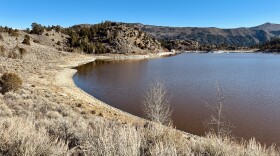-
The Sublette County lake turned red last year, leaving water quality managers stumped. Now, they think it’s because of a nontoxic native algae.
-
Dolphins in Florida that became beached during cyanobacterial blooms showed signs of a version of Alzheimer’s that could be tied to neurotoxins found in the blooms. Similar blooms plague many Wyoming waters.
-
-
Swimming or any similar contact with the water has the potential to make you, pets or livestock sick. If you, a pet or livestock touches the algae, rinse off with clean water as soon as possible.
-
Harmful cyanobacteria blooms can pose a health risk to people and animals. Avoid contact and don’t drink the water.
-
A beloved fishing lake near Pinedale now has no fish. To top it off, the entire lake turned red a couple months ago, and land managers and biologists don’t know exactly why. WyoFile’s Mike Koshmrl first reported on this in early December and gives us a debrief.
-
Cyanobacteria are still blooming in Wyoming’s lakes and reservoirs, even as autumn starts to bring temperatures below freezing. These blooms can be a real threat to pets and livestock.
-
State authorities are reminding residents to be on the lookout for cyanobacterial blooms, sometimes called blue-green algae, when visiting lakes or reservoirs this summer.
-
Harmful algal blooms are a major issue in water bodies across our region, and can be toxic to humans and animals. Some scientists have started using satellites to keep a better eye on them.
-
Seemingly more bodies of water in Wyoming are being affected by harmful algal blooms, but some experts say that might not be the case.
© 2025 Wyoming Public Media
800-729-5897 | 307-766-4240
Wyoming Public Media is a service of the University of Wyoming
800-729-5897 | 307-766-4240
Wyoming Public Media is a service of the University of Wyoming

Play Live Radio
Next Up:
0:00
0:00
Available On Air Stations











